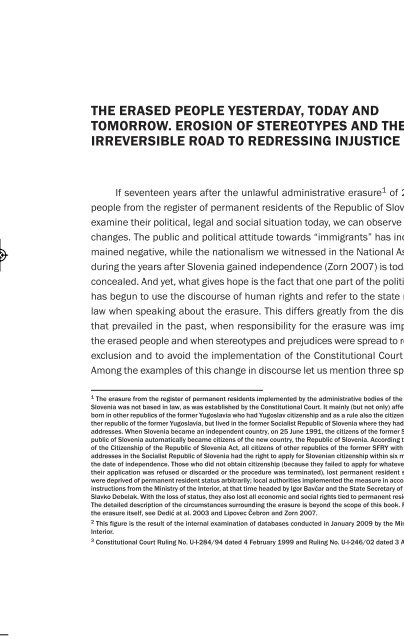The Scars of the Erasure_web
The Scars of the Erasure_web
The Scars of the Erasure_web
- No tags were found...
You also want an ePaper? Increase the reach of your titles
YUMPU automatically turns print PDFs into web optimized ePapers that Google loves.
<strong>Erasure</strong>_4a 10.1.11 20:29 Page 99THE ERASED PEOPLE YESTERDAY, TODAY ANDTOMORROW. EROSION OF STEREOTYPES AND THEIRREVERSIBLE ROAD TO REDRESSING INJUSTICEIf seventeen years after <strong>the</strong> unlawful administrative erasure 1 <strong>of</strong> 25,671 2people from <strong>the</strong> register <strong>of</strong> permanent residents <strong>of</strong> <strong>the</strong> Republic <strong>of</strong> Slovenia weexamine <strong>the</strong>ir political, legal and social situation today, we can observe positivechanges. <strong>The</strong> public and political attitude towards “immigrants” has indeed remainednegative, while <strong>the</strong> nationalism we witnessed in <strong>the</strong> National Assemblyduring <strong>the</strong> years after Slovenia gained independence (Zorn 2007) is today moreconcealed. And yet, what gives hope is <strong>the</strong> fact that one part <strong>of</strong> <strong>the</strong> political elitehas begun to use <strong>the</strong> discourse <strong>of</strong> human rights and refer to <strong>the</strong> state ruled bylaw when speaking about <strong>the</strong> erasure. This differs greatly from <strong>the</strong> discoursesthat prevailed in <strong>the</strong> past, when responsibility for <strong>the</strong> erasure was imputed to<strong>the</strong> erased people and when stereotypes and prejudices were spread to reinforceexclusion and to avoid <strong>the</strong> implementation <strong>of</strong> <strong>the</strong> Constitutional Court ruling. 3Among <strong>the</strong> examples <strong>of</strong> this change in discourse let us mention three speeches:1 <strong>The</strong> erasure from <strong>the</strong> register <strong>of</strong> permanent residents implemented by <strong>the</strong> administrative bodies <strong>of</strong> <strong>the</strong> Republic <strong>of</strong>Slovenia was not based in law, as was established by <strong>the</strong> Constitutional Court. It mainly (but not only) affected peopleborn in o<strong>the</strong>r republics <strong>of</strong> <strong>the</strong> former Yugoslavia who had Yugoslav citizenship and as a rule also <strong>the</strong> citizenship <strong>of</strong> ano -<strong>the</strong>r republic <strong>of</strong> <strong>the</strong> former Yugoslavia, but lived in <strong>the</strong> former Socialist Republic <strong>of</strong> Slovenia where <strong>the</strong>y had permanentaddresses. When Slovenia became an independent country, on 25 June 1991, <strong>the</strong> citizens <strong>of</strong> <strong>the</strong> former Socialist Republic<strong>of</strong> Slovenia automatically became citizens <strong>of</strong> <strong>the</strong> new country, <strong>the</strong> Republic <strong>of</strong> Slovenia. According to Article 40<strong>of</strong> <strong>the</strong> Citizenship <strong>of</strong> <strong>the</strong> Republic <strong>of</strong> Slovenia Act, all citizens <strong>of</strong> o<strong>the</strong>r republics <strong>of</strong> <strong>the</strong> former SFRY with permanentaddresses in <strong>the</strong> Socialist Republic <strong>of</strong> Slovenia had <strong>the</strong> right to apply for Slovenian citizenship within six months from<strong>the</strong> date <strong>of</strong> independence. Those who did not obtain citizenship (because <strong>the</strong>y failed to apply for whatever reason, or<strong>the</strong>ir application was refused or discarded or <strong>the</strong> procedure was terminated), lost permanent resident status. <strong>The</strong>ywere deprived <strong>of</strong> permanent resident status arbitrarily; local authorities implemented <strong>the</strong> measure in accordance withinstructions from <strong>the</strong> Ministry <strong>of</strong> <strong>the</strong> Interior, at that time headed by Igor Bavčar and <strong>the</strong> State Secretary <strong>of</strong> <strong>the</strong> Interior,Slavko Debelak. With <strong>the</strong> loss <strong>of</strong> status, <strong>the</strong>y also lost all economic and social rights tied to permanent resident status.<strong>The</strong> detailed description <strong>of</strong> <strong>the</strong> circumstances surrounding <strong>the</strong> erasure is beyond <strong>the</strong> scope <strong>of</strong> this book. For more on<strong>the</strong> erasure itself, see Dedić at al. 2003 and Lipovec Čebron and Zorn 2007.2 This figure is <strong>the</strong> result <strong>of</strong> <strong>the</strong> internal examination <strong>of</strong> databases conducted in January 2009 by <strong>the</strong> Ministry <strong>of</strong> <strong>the</strong>Interior.3 Constitutional Court Ruling No. U-I-284/94 dated 4 February 1999 and Ruling No. U-I-246/02 dated 3 April 2003.


